The Corsair Force MP510 SSD (960GB) Review: A High-End Contender
by Billy Tallis on October 18, 2018 10:00 AM ESTAnandTech Storage Bench - The Destroyer
The Destroyer is an extremely long test replicating the access patterns of very IO-intensive desktop usage. A detailed breakdown can be found in this article. Like real-world usage, the drives do get the occasional break that allows for some background garbage collection and flushing caches, but those idle times are limited to 25ms so that it doesn't take all week to run the test. These AnandTech Storage Bench (ATSB) tests do not involve running the actual applications that generated the workloads, so the scores are relatively insensitive to changes in CPU performance and RAM from our new testbed, but the jump to a newer version of Windows and the newer storage drivers can have an impact.
We quantify performance on this test by reporting the drive's average data throughput, the average latency of the I/O operations, and the total energy used by the drive over the course of the test.
The Patriot Hellfire, in blue, is highlighted as an example of a last-generation Phison E7 drive. Although we didn't test it at the time, the MP500 was based on the same controller and memory.
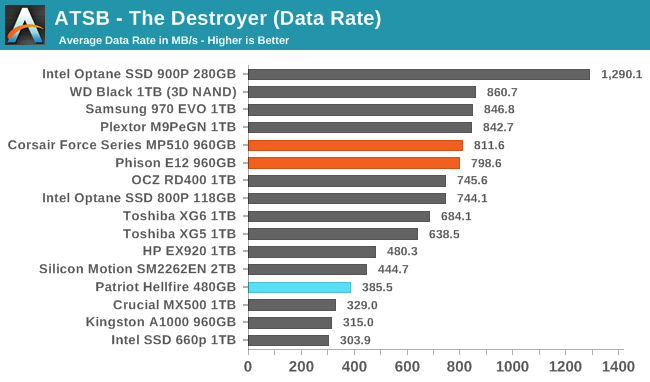
The Corsair Force MP510's average data rate on The Destroyer is only a few percent slower than the fastest TLC-based SSD we've tested, and is more than twice as fast as the previous generation Phison E7 drives.
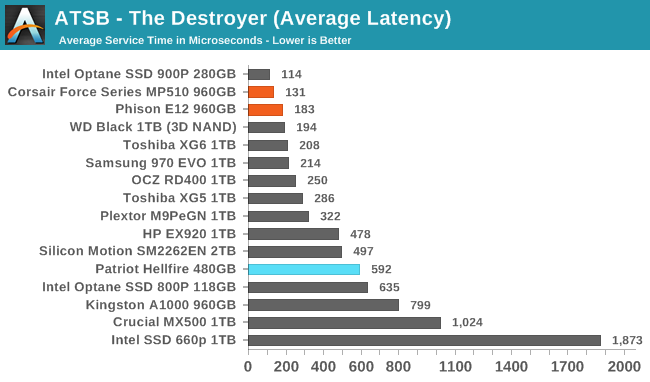
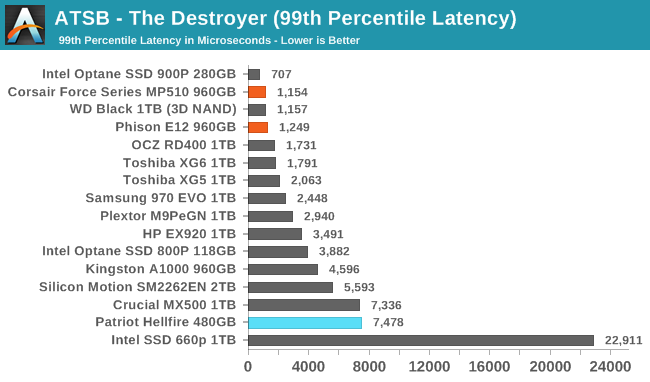
The average and 99th percentile latency scores from the MP510 are best in class, pulling slightly ahead of the other drives that use the same BiCS TLC NAND.
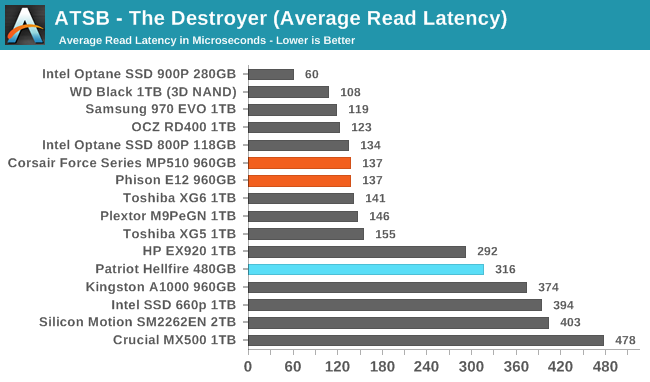
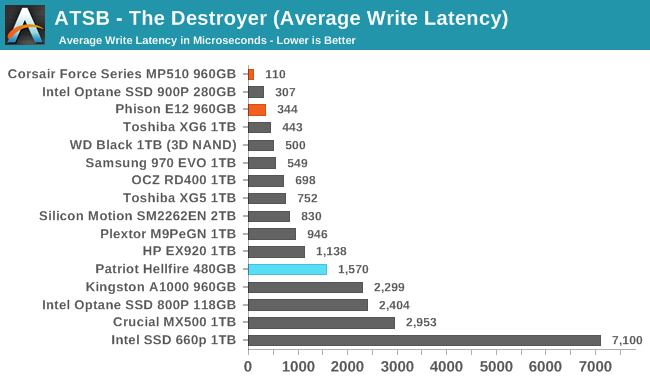
The average read latency of the MP510 is a bit slower than the fastest NAND-based SSDs but still clearly falls within the top tier of drives. The average write latency is impressively low, showing that the drive has very effective write caching.
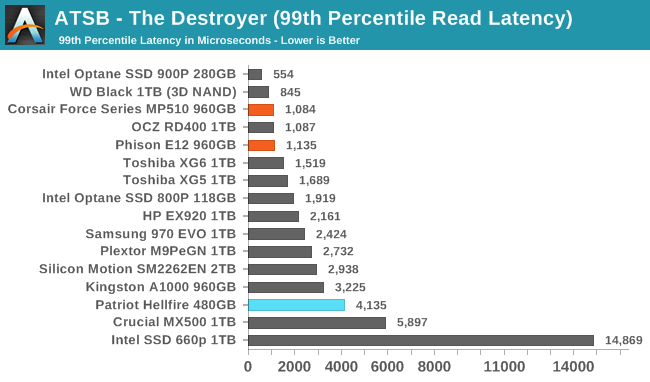
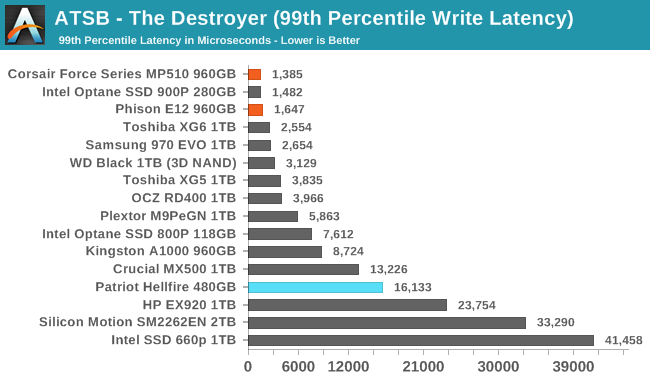
The 99th percentile write latency score for the Corsair MP510 is the best we've seen, and the 99th percentile read latency also excellent but doesn't quite set a new record.
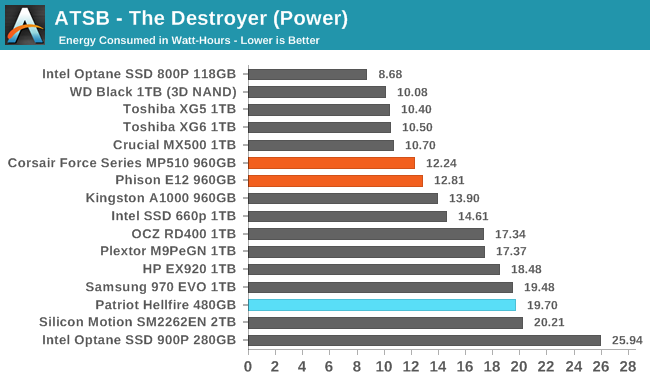
The Corsair Force MP510 uses a bit more energy over the course of The Destroyer than the most efficient flash-based SSDs (which use the same BiCS TLC NAND), but the MP510's efficiency is still significantly better than average for a high-end NVMe SSD.










42 Comments
View All Comments
imaheadcase - Thursday, October 18, 2018 - link
Wow, i had no idea how cheap SSD have come. You know, its getting to price points soon that home servers would easily use SSD drives vs mechanical.bill.rookard - Thursday, October 18, 2018 - link
If a 4TB drive becomes somewhat more affordable, then yes, they can. I guess it depends on how big of a server array you have. Personally, I have about 30TB in a 2U server using 4x4tb ZFS + 4x3tb ZFS for 20TB effective. Even a bargain basement setup for a similar size using the cheapest Micron 1100's 2TB SSDs you could find - you'd need 11 of them @ $280 each.Or - just a stitch over $3000.00. Meanwhile, the drives I used were factory refurbed enterprise drives and all 8 of them cost around $500.00
nathanddrews - Thursday, October 18, 2018 - link
I'm definitely waiting for larger SSDs to come down. I think if we ever get to $100/TB, I'll start to swap out more drives. 2TB for $199 would be great.I only recently started to experiment with "hybrid" storage on my home server. I've got about 40TB of rust with about 800GB of SSDs (older SSDs that didn't have a home anymore), using software to manage what folders/files are stored/backed up on which drives. UHD Blu-ray and other disc backups on the slow hard drives (still fast enough to saturate 1GbE) and documents/photos, etc. on the SSD array. My server doesn't have anything faster than SATA6Gbps, but the SSDs are still much quicker for smaller files/random access.
Lolimaster - Thursday, October 18, 2018 - link
I would upgrade to cheap 2.5-5Gbit NICnathanddrews - Thursday, October 18, 2018 - link
I've already got a couple 10GbE NICs, just waiting on an affordable switch...leexgx - Thursday, October 18, 2018 - link
use a PC :) youtube video of a person doing it do need to make sure you have the right mobo so it can handle 10gb speeds between PCI-E 10GB cards or you be getting low speeds between cards (still far cheaper than a actual 10gb switch)https://www.youtube.com/watch?v=p39mFz7ORco
Valantar - Friday, October 19, 2018 - link
You're recommending running a PC 24/7 as a switch to provide >GbE speeds from a NAS? Really?nathanddrews - Friday, October 19, 2018 - link
LOL that's a good joke! I mean, it's creative, but there's no way I'm doing that. I can wait a little longer to get a proper switch(es).rrinker - Thursday, October 18, 2018 - link
I'm at the point of contemplating a new server for home, and hybrid was the way I was going to go, since 16TB or so of all SSD is just too expensive still. But 1-2TB of SSD as fast cache for a bunch of 4TB spinny drives would be relatively inexpensive and offer most of the benefits. And SSD for the OS drive of course.DominionSeraph - Monday, October 22, 2018 - link
Yup, I picked up 24TB for $240. SSDs really can't compete.